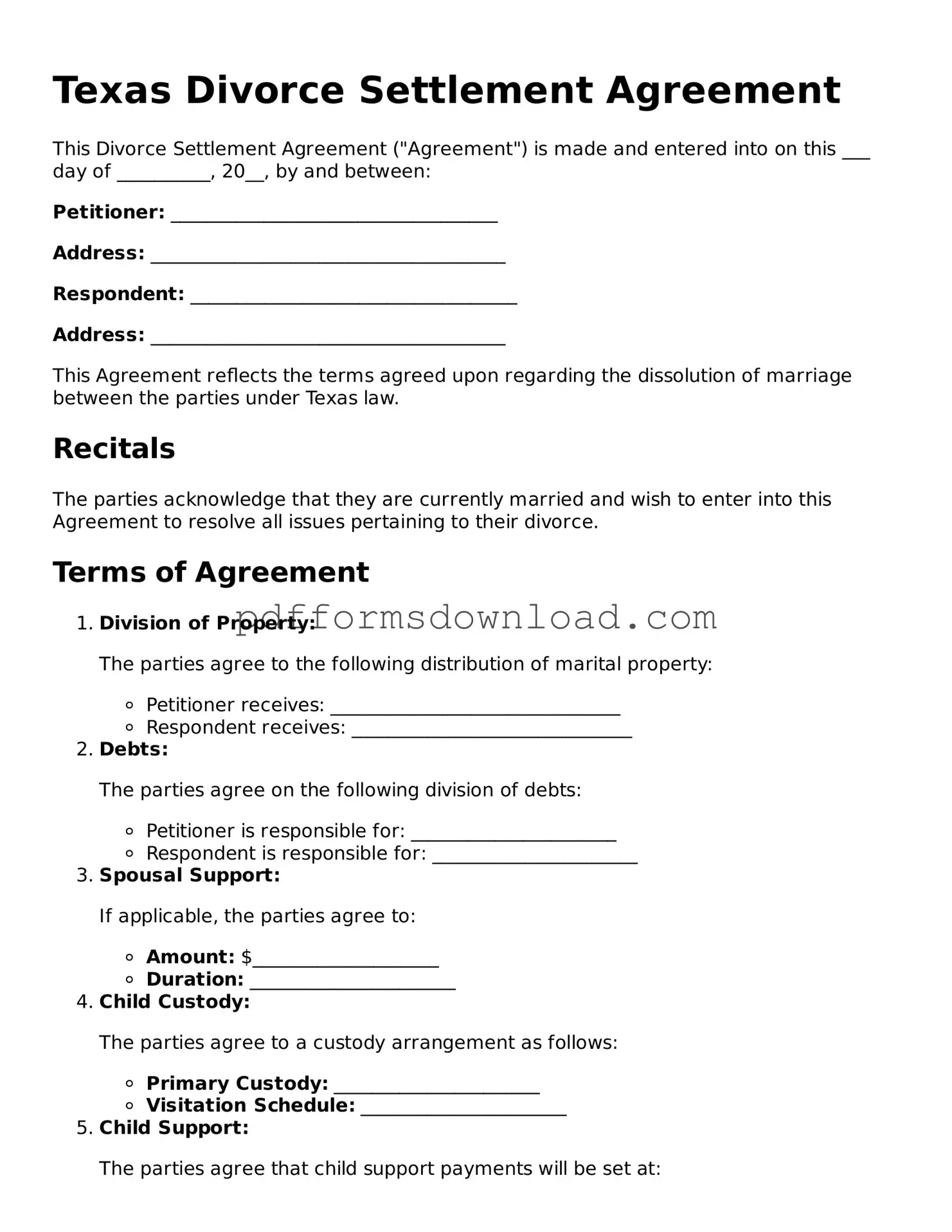What is a Texas Divorce Settlement Agreement?
A Texas Divorce Settlement Agreement is a legal document that outlines the terms of a divorce between two parties. It typically covers issues such as property division, child custody, child support, and spousal support. This agreement is crucial as it helps both parties understand their rights and responsibilities post-divorce.
How do I create a Divorce Settlement Agreement in Texas?
To create a Divorce Settlement Agreement, both parties should first discuss and negotiate the terms they wish to include. It's advisable to draft the agreement in writing, ensuring all terms are clear and unambiguous. Once both parties agree, they should sign the document in front of a notary public to make it legally binding.
Do I need a lawyer to draft a Divorce Settlement Agreement?
While it is not legally required to have a lawyer, consulting with one is highly recommended. A lawyer can provide valuable insights, help ensure that the agreement complies with Texas law, and protect your interests. If the agreement is complex, legal assistance becomes even more crucial.
Can I modify a Divorce Settlement Agreement after it has been signed?
Yes, a Divorce Settlement Agreement can be modified after it has been signed, but both parties must agree to the changes. It is advisable to document any modifications in writing and have both parties sign the amended agreement. In some cases, a court may need to approve the changes, especially if they involve child custody or support.
What happens if one party does not comply with the agreement?
If one party fails to comply with the terms of the Divorce Settlement Agreement, the other party can seek enforcement through the court. This may involve filing a motion to enforce the agreement, which can lead to legal consequences for the non-compliant party, including fines or changes in custody arrangements.
Is a Divorce Settlement Agreement legally binding?
Yes, once signed by both parties and notarized, a Divorce Settlement Agreement is legally binding. It holds the same weight as a court order, and both parties are obligated to adhere to its terms. However, it must be approved by the court to be enforceable in a legal sense.
What if we cannot agree on the terms of the Divorce Settlement Agreement?
If the parties cannot reach an agreement, they may need to consider mediation or go to court for a judge to decide the terms of the divorce. Mediation can provide a neutral environment for discussion and may help facilitate a resolution without the need for a lengthy court battle.
How long does it take to finalize a Divorce Settlement Agreement in Texas?
The time it takes to finalize a Divorce Settlement Agreement varies depending on the complexity of the case and the willingness of both parties to negotiate. If both parties are cooperative, it can take a few weeks. However, if disputes arise, the process could extend to several months or longer.
What should be included in a Divorce Settlement Agreement?
A comprehensive Divorce Settlement Agreement should include provisions for property division, debt allocation, child custody arrangements, visitation schedules, child support amounts, and spousal support terms. Clear definitions and specifics about each area will help prevent misunderstandings in the future.
Can a Divorce Settlement Agreement address future changes in circumstances?
While a Divorce Settlement Agreement can outline current terms, it is also wise to include provisions for future changes, such as adjustments to child support or custody arrangements. This foresight can help both parties navigate potential life changes without unnecessary conflict.
